| |
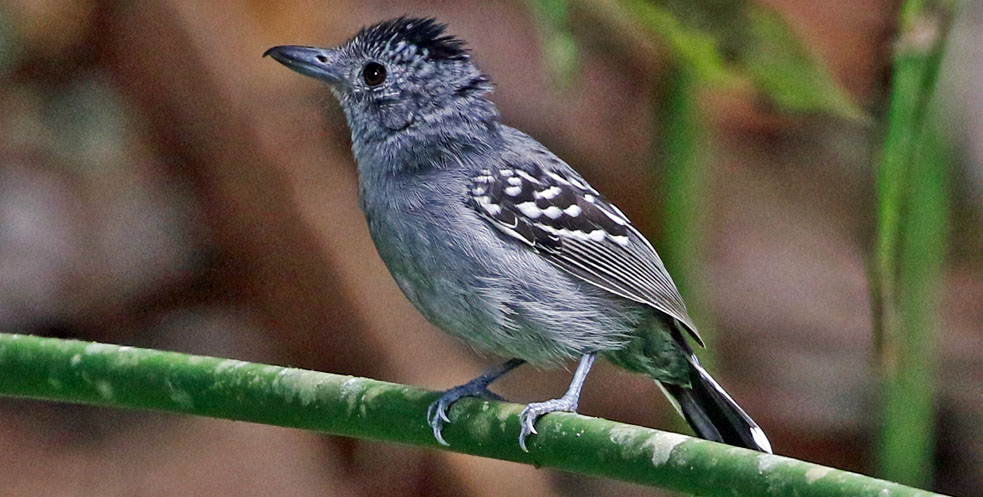 |
ANTBIRDS Thamnophilidae |
- 237 species in the Neotropics
- DR personal total: 114 species (48%), 35 photo'd
|
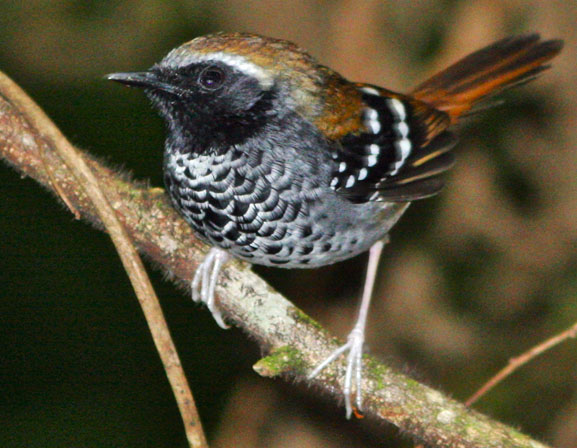 The Antbirds are a large family found only in the Neotropics. Most reside in lowland forests where they have adapted to niches ranging from dense thornscrub to humid jungle. Almost all are plumaged in various shades of black, gray, or rufous, but male and female plumages are often dramatically different. The male Black-crowned Antshrike (above) is dark gray with black crown and black wing-coverts; the female is all rufous with brown wing-coverts. Black-crowned Antshrike is a member of genus Thamnophilus, the most familiar antshrike genus, with 30 species. Black-crowned occurs from Central America to Ecuador, and is a split from what used to be called "Slaty Antshrike." Pairs duet, and these calls often dominate lowland forests. They seem to be calling constantly during a walk along Pipeline Road, Panama. The Antbirds are a large family found only in the Neotropics. Most reside in lowland forests where they have adapted to niches ranging from dense thornscrub to humid jungle. Almost all are plumaged in various shades of black, gray, or rufous, but male and female plumages are often dramatically different. The male Black-crowned Antshrike (above) is dark gray with black crown and black wing-coverts; the female is all rufous with brown wing-coverts. Black-crowned Antshrike is a member of genus Thamnophilus, the most familiar antshrike genus, with 30 species. Black-crowned occurs from Central America to Ecuador, and is a split from what used to be called "Slaty Antshrike." Pairs duet, and these calls often dominate lowland forests. They seem to be calling constantly during a walk along Pipeline Road, Panama.
Squamate Antbird (left) is beautifully patterned in both males and females, but only the male has a black throat. It is endemic to forests in southeastern Brazil, living in pairs in the understory, and remaining difficult to see. |
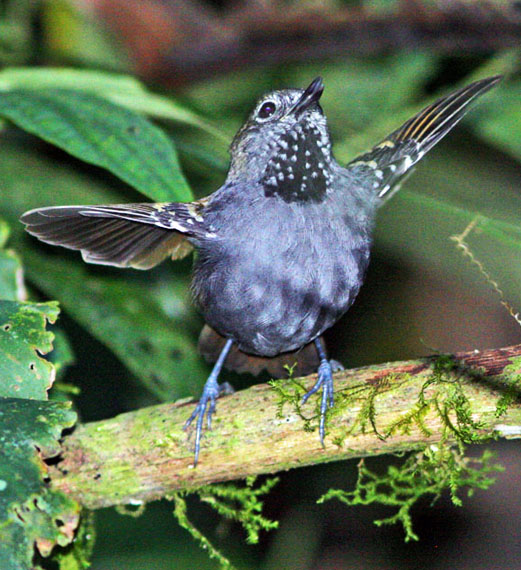 |
The third large set in the family are antwrens; most are sexually dimorphic Some, like Star-throated Antwren (left), another southeast Brazil endemic in a monotypic genus, have similar plumages, but most, like the widespread Dot-winged Antwren (below) wear distinctive plumages (female above, male below).
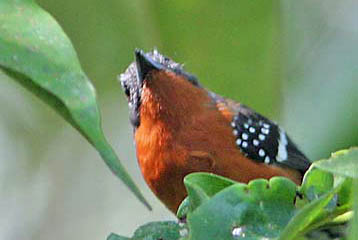
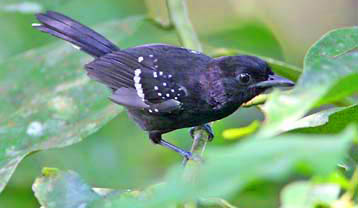
|
|
 Unlike other suboscines about which there has been confusion over the boundaries between families (particularly in the cotinga-manakin-flycatcher sets), the Thamnophilidae are a well recognized and well defined group once it became clear that the antpittas [Grallariidae] and the antthrushes [Formicariidae] were different families. The remaining Antbirds are a monophyletic group of more than 230+ species in 60 genera. All are small to mid-sized predators, and it is easy to determine what is and what is not an antbird. Almost all species are monogamous with evidently permanent pair bonds; most antbirds live in pairs, communicating with loud, diagnostic songs. They are generally constrained in pattern and color combinations and most have similar bill shapes. Their elevational distribution is very truncated, with few species occurring above ~1300 m, and most are lowland birds below 600 m elevation. It seems remarkable that a family that shows such restrictions contains so many species. Their species richness is associated with extreme habitat and foraging specialization. Unlike other suboscines about which there has been confusion over the boundaries between families (particularly in the cotinga-manakin-flycatcher sets), the Thamnophilidae are a well recognized and well defined group once it became clear that the antpittas [Grallariidae] and the antthrushes [Formicariidae] were different families. The remaining Antbirds are a monophyletic group of more than 230+ species in 60 genera. All are small to mid-sized predators, and it is easy to determine what is and what is not an antbird. Almost all species are monogamous with evidently permanent pair bonds; most antbirds live in pairs, communicating with loud, diagnostic songs. They are generally constrained in pattern and color combinations and most have similar bill shapes. Their elevational distribution is very truncated, with few species occurring above ~1300 m, and most are lowland birds below 600 m elevation. It seems remarkable that a family that shows such restrictions contains so many species. Their species richness is associated with extreme habitat and foraging specialization.
The three major sets — antshrikes (53 species in 14 genera), antbirds (96 species in 33 genera), and antwrens (61 species in 8 genera) — comprise 89% of all the species in the Thamnophilidae. The first European naturalists to encounter New World antbirds confused them with Old World groups, and particularly they confused them with shrikes [Laniidae] because of the heavy, hooked bill of some species. It wasn't until 1847 when German anatomist J. Müller discovered that the syrinx of a number of New World groups, including antbirds, was very different than Old World groups that things began to be sorted out (Zimmer & Islet 2003). Yet the names remain, comparing species in the Thamnophilidae with species in other unrelated groups. The remaining species are:
- 8 antvireos in genus Dysithamnus — a female Spot-crowned Antvireo is shown at right;
- 8 stipplethroats in one genus (all derived from the Epinecrophylla haematonota complex, which were formerly included in a single species "Stipple-throated Antwren"];
- 5 fire-eyes in one genus (Pyriglena);
- 3 bare-eyes in one genus (Phlegopsis); and
- 3 bushbirds in two genera (Neoctantes, Clytoctantes).
|
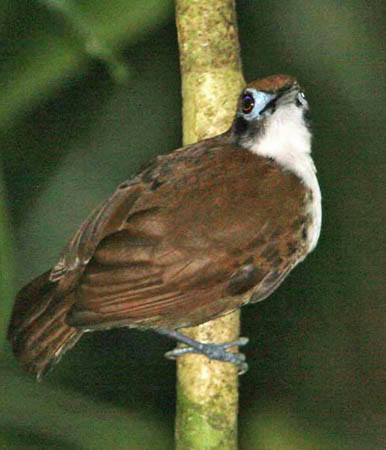 Although most members of the Antbird family have the word "ant" in their name, that does not imply that they all eat ants. Their diet is almost exclusively arthropods. However, a subset of Antbirds are known to follow "army ants". I think that perhaps the most fascinating group of Antbirds are the dedicated ant-swarm followers. These follow "army-ants" [subfamily Dorylinae] and especially the widespread Eciton burchelli, "a diurnal swarm raider, fanning out along broad fronts containing hundreds of thousands of ravenous carnivorous ants. In the process, these flush large number of arthropods and small vertebrates, many of which are normally concealed in leaf litter. Ahead of the swarm await opportunistic birds and parasitic wasps and flies, ready to pounce on potential prey or hosts fleeing the ants. The birds do not eat the ants. . . rather, the army ants provide an important service that greatly increases foraging efficiency... the bird allow the ants to act as 'beater,' which drive an abundance of prey right into their laps;" Zimmer & Isler (2003). Although most members of the Antbird family have the word "ant" in their name, that does not imply that they all eat ants. Their diet is almost exclusively arthropods. However, a subset of Antbirds are known to follow "army ants". I think that perhaps the most fascinating group of Antbirds are the dedicated ant-swarm followers. These follow "army-ants" [subfamily Dorylinae] and especially the widespread Eciton burchelli, "a diurnal swarm raider, fanning out along broad fronts containing hundreds of thousands of ravenous carnivorous ants. In the process, these flush large number of arthropods and small vertebrates, many of which are normally concealed in leaf litter. Ahead of the swarm await opportunistic birds and parasitic wasps and flies, ready to pounce on potential prey or hosts fleeing the ants. The birds do not eat the ants. . . rather, the army ants provide an important service that greatly increases foraging efficiency... the bird allow the ants to act as 'beater,' which drive an abundance of prey right into their laps;" Zimmer & Isler (2003).
Nothing cheers the heart of a Neotropical birder like finding an active swarm of army ants on the forest floor, attended by many bird species. "Some 18 species in seven genera are considered 'obligate' ant followers, which are almost never found away from the ants. Beyond the 18 'obligates,' a half-dozen species in four genera are regular ant-followers but can be frequently found away from the ants" (ibid.). The ant-followers are especially evolved to sit "sideways" on vertical saplings above the ant swarms on the forest floor [woe to that bird that itself gets trapped by the ants!... the ants will eat anything]. So the specialized antbirds forage just above or in front of the ants, snapping up prey from their vertical perches. Here (left) is an ant-follower, Bicolored Antbird, perched sideways on a vertical stem.
|
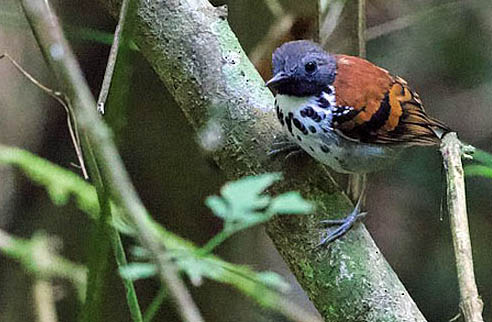 Another ant-follower is Spotted Antbird, ranging from Central America to Ecuador (nice shot from Panama by Terence Degan, right). It is one of three species in genus Hylophylax, which means "woodland watcher" in Latin. The impression that the Spotted Antbird is a "spotted watcher of the woodland" is also mirrored in Panama's Darién province where the species is locally known as 'corregidor' (mayor) for its apparent behavior of directing the activities of other birds found with it, presumably at army ant swarms (Wetmore 1972, Willis 1972). Another ant-follower is Spotted Antbird, ranging from Central America to Ecuador (nice shot from Panama by Terence Degan, right). It is one of three species in genus Hylophylax, which means "woodland watcher" in Latin. The impression that the Spotted Antbird is a "spotted watcher of the woodland" is also mirrored in Panama's Darién province where the species is locally known as 'corregidor' (mayor) for its apparent behavior of directing the activities of other birds found with it, presumably at army ant swarms (Wetmore 1972, Willis 1972).
Hylophylax and Rhegmatorhina antbirds and among the obligate ant-followers. One of the Rhegmatorhina antbirds, a Brazilian endemic, is called Bare-eyed Antbird R. gymnops as it has bare blue skin around the eyes, as do all the species in that genus. So do all three of the Hafferia antbirds, and all three species called Bare-eyes in genus Phlegopsis (two with reddish bare skin, one with white). The bare skin around the eye is even broader, including the auriculars, in the lovely Ocellated Antbird Phaenostictus mcleannani, while the blue bare skin covers the entire forecrown on a male Bare-crowned Antbird Gymnocichla nudiceps. All of these are ant-followers (some of them obligate followers). It has been hypothesized that the bare skin helps to protect the eyes from ants. All of the antbirds lists in this paragraph are highly sought-after species by Neotropical birders.
|
 Much has been learned about antbirds in recent decades, with a multitude of new species that were discovered within the last 40 years, and many others elevated from previously lumped groups, at a rapid pace, even among authorities strictly conforming to the biological species concept. For example, Sibley & Monroe (1990) listed 188 species of antbirds. A dozen years later, Dickinson (2003) listed 206 while Zimmer & Isler (2003) tallied 209 species. This was an addition of 21 species in those 13 years and illustrated how rapidly new information was being gathered in South America. At this update (2022), using Clements/SACC's lists, the total is 237 species (and I expect more splits in the future). Much has been learned about antbirds in recent decades, with a multitude of new species that were discovered within the last 40 years, and many others elevated from previously lumped groups, at a rapid pace, even among authorities strictly conforming to the biological species concept. For example, Sibley & Monroe (1990) listed 188 species of antbirds. A dozen years later, Dickinson (2003) listed 206 while Zimmer & Isler (2003) tallied 209 species. This was an addition of 21 species in those 13 years and illustrated how rapidly new information was being gathered in South America. At this update (2022), using Clements/SACC's lists, the total is 237 species (and I expect more splits in the future).
As just one example of recent split, the current 8 species of Stipplethroats all derived from the Epinecrophylla haematonota complex — they were formerly included in a single species "Stipple-throated Antwren!" (see Hackett & Rosenberg 1990 and progeny). There were suddenly so many extra "antwrens" in genus Epinecrophylla that the SACC coined the new English word Stipplethroats. One of those is Checkered-throated Stipplethroat (left, a female), another species ranging from Central America to western Ecuador. It is the only Stipplethroat west of the Andes. |
Like all species of Epinecrophylla, the Checker-throated Stipplethroat searches for arthropods that are hidden in curled, dead leaves that are trapped in vine tangles and other sites above the ground. Ken Rosenberg and colleagues call that "working in the aerial leaf-litter" (e.g., Rosenberg 1993).
 When my little party of California birders visited Explorer's Inn in southeastern Peru in 1987, we came upon researcher Ken Rosenberg, then working on post-graduate studies. He was studying "dead leaf gleaners" — most of them antwrens but also some antshrikes and birds from other families — in a broadscale conceptual project that had first been proposed by Van Remsen and Ted Parker (e.g., Remsen & Parker 1984). In an evergreen forest of broadleaf trees, there is always an abundance of hanging dead leaves. These are perfect places to hide nocturnal foragers during the day. What the LSU researchers found, including in the studies eventually published by Rosenberg (1993, 1997), is that specific antbirds rely heavily on dead-leaf-foraging for their livelihood. Many search the dead leaves for anything hidden inside while moving with a mixed species flock. They are hanging upside down and peering into clusters of dead leaves while others in the flock are searching branches or live leaves. Some species are "obligate" dead-leafers, with 99% of their prey taken that way. Examples include Ornate Antwren Myrmotherula ornata and White-flanked Antwren M. axillaris, and all of the Epinecrophylla stipplethroats. When my little party of California birders visited Explorer's Inn in southeastern Peru in 1987, we came upon researcher Ken Rosenberg, then working on post-graduate studies. He was studying "dead leaf gleaners" — most of them antwrens but also some antshrikes and birds from other families — in a broadscale conceptual project that had first been proposed by Van Remsen and Ted Parker (e.g., Remsen & Parker 1984). In an evergreen forest of broadleaf trees, there is always an abundance of hanging dead leaves. These are perfect places to hide nocturnal foragers during the day. What the LSU researchers found, including in the studies eventually published by Rosenberg (1993, 1997), is that specific antbirds rely heavily on dead-leaf-foraging for their livelihood. Many search the dead leaves for anything hidden inside while moving with a mixed species flock. They are hanging upside down and peering into clusters of dead leaves while others in the flock are searching branches or live leaves. Some species are "obligate" dead-leafers, with 99% of their prey taken that way. Examples include Ornate Antwren Myrmotherula ornata and White-flanked Antwren M. axillaris, and all of the Epinecrophylla stipplethroats.
Other species are "regular" dead-leafers — examples are the 8 members of the "warbling-antbird" genus Hypocnemis (right, in another fabulous Arthur Grosset shot). Seven of the eight species were once considered a single widespread bird called "Warbling Antbird," but now there are seven species of warbling-antbirds. This particular bird is Peruvian Warbling-Antbird, ranging across e. Peru, s.w. Brazil, and n.w. Bolivia. Note the dead leaf attached to the branch being used by the hungry antbird! There are 10 named races of Warbling Antbird; The studies cited (Remsen & Parker 1984, Rosenberg 1993, 1997) show that the warbling-antbirds are "regular" but not "obligate" user of the dead-leaf resource, with 31% of foraging observations in this unique substrate. |
 Yet another part of the fascinating story of antbirds is their part in the mixed-species flocks in the Neotropical lowland forests. There are canopy flocks, mid-story flocks, and undergrowth flocks, often composed of 25-50 individuals of 10-30 species. Antwrens are particularly common in the upper-level flocks, and often the 'core' species is an antwren. It is not unusual to have a half-dozen antwren species in a good Amazonian forest flock. Many of them are small Myrmotherula antwrens or stipplethroats, but often there will be a larger Herpsilochmus antwren pair. An example is Large-billed Antwren (left), of central South American in cerrado, gallery woodlots, or river island. There are 18 species in genus Herpsilochmus, and male plumage is a typical mix of gray, black and white in all species. n contrast, female plumages are more distinctive; the Large-billed female has a bright orange head and breast. Yet another part of the fascinating story of antbirds is their part in the mixed-species flocks in the Neotropical lowland forests. There are canopy flocks, mid-story flocks, and undergrowth flocks, often composed of 25-50 individuals of 10-30 species. Antwrens are particularly common in the upper-level flocks, and often the 'core' species is an antwren. It is not unusual to have a half-dozen antwren species in a good Amazonian forest flock. Many of them are small Myrmotherula antwrens or stipplethroats, but often there will be a larger Herpsilochmus antwren pair. An example is Large-billed Antwren (left), of central South American in cerrado, gallery woodlots, or river island. There are 18 species in genus Herpsilochmus, and male plumage is a typical mix of gray, black and white in all species. n contrast, female plumages are more distinctive; the Large-billed female has a bright orange head and breast.
To a birder, these flocks are both exciting and frustrating. One may have walked an hour and seen nothing in the humid heat of the jungle, and then suddenly there are birds all around. There are so many that you don't have time to spend with any of them — just try to identify what you can and move on to the next one. All too soon the flock has passed on, moving away from the trail and into the inaccessible thickets. You've heard and glimpsed birds everywhere, but you only managed to see perhaps 20, and then you identified only half of those! And that's with a modern field guide!
It was much more difficult back in the 'old days' — as in my visits to Colombia (1975) or Peru (1987) — when there were no field guides save the thick tome by Meyer de Schauensee (1970) that had almost no plates but, rather, obscure descriptions ["looks like no. 27 but browner"] for most of the antbirds. Current birders have no idea how easy they have it now by comparison, and those on tours with professional guides pointing out the birds, often on vocalizations — well, you are just so pampered!
Of course while there are plenty of antwrens that join mixed species flocks, there are a different set that live near the ground in pairs, such as the nine antwrens in genus Formicivora. Here (below) is Rusty-backed Antwren: male with black throat and breast, fringed all around with white, with rusty upperparts and tail, and black-and-white patterned upperwing coverts (below left) and a female with a black-and-white streaked throat and breast (below right). This species lives in pairs in dense undergrowth in a large swathe of southern Brazil, and locally elsewhere, and pairs communicate with loud, diagnostic songs. These in genus Formicivora are large for "antwrens," and both the size and behavior recalls a number of "antbirds" (such as the 11 species of Drymophila antbirds) — the distinction between antwrens and antbirds breaks down in some of these species. |
|
|
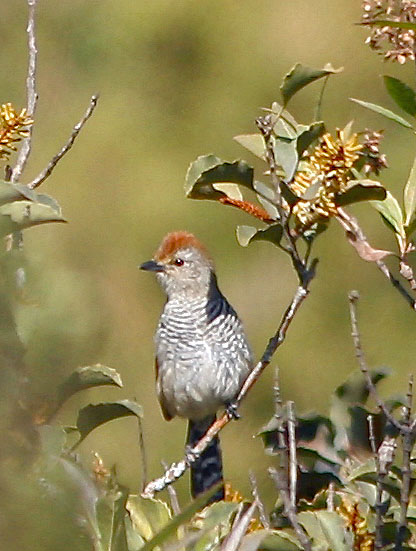 Among the Thamnophilidae, antshrikes might be the most conspicuous because of their sometimes aggressive behavior, their rollicking calls, the conspicuous crest on some species, and their largish size for this family. Barred Antshrike (above) has perhaps the widest range of any of the family, occurring from southern Mexico (to northern Argentina. Zimmer & Isler (2003) recognize a dozen races. It is a common, well-known, and marvelous bird with much duetting among pairs. The photos above are of a pair: male (left) and female (right). Sexual dimorphism is great among most antshrikes, with males tending toward more blacks and grays, and females sporting rufous or rusty tones. Barred Antshrike is one of 30 species in genus Thamnophilus, and by far the best-studied; another is Rufous-capped Antshrike (right, a male), about which very little is known. It has a patchy distribution along the eastern foothills of the Andes, and then again in southeastern Brazil, where this pair was in dense scrub in the foothills. Among the Thamnophilidae, antshrikes might be the most conspicuous because of their sometimes aggressive behavior, their rollicking calls, the conspicuous crest on some species, and their largish size for this family. Barred Antshrike (above) has perhaps the widest range of any of the family, occurring from southern Mexico (to northern Argentina. Zimmer & Isler (2003) recognize a dozen races. It is a common, well-known, and marvelous bird with much duetting among pairs. The photos above are of a pair: male (left) and female (right). Sexual dimorphism is great among most antshrikes, with males tending toward more blacks and grays, and females sporting rufous or rusty tones. Barred Antshrike is one of 30 species in genus Thamnophilus, and by far the best-studied; another is Rufous-capped Antshrike (right, a male), about which very little is known. It has a patchy distribution along the eastern foothills of the Andes, and then again in southeastern Brazil, where this pair was in dense scrub in the foothills.
Antshrikes of various sizes and behaviors are scattered across 14 genera. Those in genus Sakesphorus are three mid-sized antshrikes usually restricted to understory habitats. Giant Antshrike Batara cinerea is a huge, long-tailed antshrike in a monotypic genus that has an odd distribution: foothills on the east side of the Andes and then a distinct range in southeastern Brazil and adjacent countries. Despite its size and loud songs, it is shy and hard to see. Likewise, the two species in genus Mackenziaena are large, dark birds of the Atlantic forest of southeast Brazil and adjacent countries, which are also very secretive; my single photo (below left) is of a female Large-tailed Antshrike hiding inside the understory scrub.
Genus Cymbilaimus has just two species of mid-sized antshrikes in the lowlands. One is the widespread Fasciated Antshrike (below right; a male), ranging from Central America through the Amazon Basin. It is a mid-story species of vine tangles, but also joins mixed-species flocks in the sub-canopy.. |
|
The second species in genus Cymbilaimus is the opposite in distribution. Bamboo Antshrike C. sanctaemariae is comparatively recently described species that is a habitat specialist. It looks very similar to Fasciated Antshrike — males are black with many fine white bars, while females replace the crown and underparts with rich rufous —but Bamboo Antshrike is restricted to Guadua bamboo in the southwestern Amazon Basin. It has distinctive vocalizations. The discovery of this species epitomizes the importance of both habitat specialization and distinct vocalizations in the determination of species ranking. During my first major trip to Peru (1987), we stayed at Explorer's Inn in Tambopata reserve, Made de Dios, where Ken Rosenberg was studying "dead-leaf-gleaners" (as discussed above). We borrowed his tape of the recently named Bamboo Antshrike (Pierpont & Fitzpatrick 1983), and were able to find four of them in bamboo stands not far distance from the Lodge.
On arrival at Explorer's Inn, we also learned that an all-black "new" Cercomacra antbird had just been discovered by LSU researchers in Guadua bamboo thickets across the Madre de Dios River from Explorer's Inn. We were able to copy a tape of its odd duck-like quacking call, and bum a ride across the river on two afternoons. With some good luck and tape-playback, my friends and I got good looks at the new species — the first time I'd ever seen "a bird with no name," to wit, a species yet unknown to science. This was thrilling, even if I had nothing to do with the discovery. I was even able to record my own tape of the bird, thus having in hand a unique tape of an undescribed species.
The species was later formally described by Fitzpatrick & Willard (1990) as the Manu Antbird Cercomacra manu. Since then its range has been found to be much broader than southeastern Peru, as it is patchily scattered across southern Amazonia and appears to be fairly common locally (Zimmer & Isler 2003). Indeed, I would encounter it a dozen years later along the Rio Cristalino in central Brazil. But there is nothing quite like the experience of being one of the first few non-native observers to see a newly-discovered bird species in the wild.
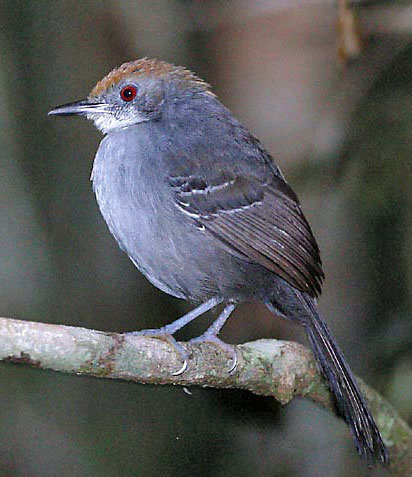 It is often those rare and specialized antbirds that capture the attention of world birders. Slender Antbird, a female of which is so beautifully shown in this Arthur Grosset shot (right), is found only locally in two states in eastern Brazil, among a specialized habitat known as mata-de-cipó — understory of remnants of hillside deciduous forest with many lianas [cipiós] and high precipitation. This restricted range species is considered Endangered (Birdlife International 2000). Additional information on the endangered Slender Antbird was published by Willis & Oniki (1981). It is often those rare and specialized antbirds that capture the attention of world birders. Slender Antbird, a female of which is so beautifully shown in this Arthur Grosset shot (right), is found only locally in two states in eastern Brazil, among a specialized habitat known as mata-de-cipó — understory of remnants of hillside deciduous forest with many lianas [cipiós] and high precipitation. This restricted range species is considered Endangered (Birdlife International 2000). Additional information on the endangered Slender Antbird was published by Willis & Oniki (1981).
I've been fortunate to have a few experiences with antbirds that were rare, local, little-known or undescribed to science. When Rita and I visited La Selva Lodge in eastern Ecuador in April 1992, we made a special effort to search out the very scarce and local Cocha Antshrike Thamnophilus praecox, a bird that still appears to be restricted to limited black-water thickets in the Rio Napo drainage of northeast Ecuador. Our local guide Fausto, although he spoke very little English, knew exactly where it would be. We were able to return the favor when we discovered a Black Bushbird Neoctantes niger on a day's hike into the terra firme forest. It was an entirely new bird for Fausto, despite his years of guide services. We had great views as it hammered and probed the viney thickets with its unique bill.
The evolution of antbirds into a multitude of niches, including those characterized by mixed species flocks, or as army-ant followers, or as "dead-leafers" and much more, has been a lifelong study by famed ecologist E.O. Willis. Willis was the world's most prominent authority on ants, on which he published many papers, but that research took him into the realm of antbirds as well, for example, army-ant following (Willis & Oniki 1978).
On a personal note, when I first posted an earlier version of this page in 2004, I had seen 83 species of antbirds but photographed only six of them in the days before digital cameras. On the whole, the understory antbirds are "photophobic, shunning even small patches of sunlight" (Zimmer & Isler 2003). No wonder seeing antbirds — let alone photographing them — was once a real challenge! Today, digital cameras with high ISO permit photo attempts in very low light — even without a flash. A superior digital camera with a Fresnel-style photo-flash attachment not only permits photography in the dark understory, but also of canopy species otherwise back-lit against a bright sky. On a recent trip to Panama, Terence Degan allowed me to aim his gear at a singing antwren in the canopy — a male Rusty-winged Antwren (below). I am amazed that advances in photography now permit us to view details of canopy and understory antbirds that we could not even view in binoculars!
I looked up this species in Cornell's current on-line Birds of the World, and discovered that "despite its wide range, the breeding biology, diet, and general natural history of Rusty-winged Antwren remain almost entirely undocumented." (Greeney & Boesman 2021). Thus the study of antbirds is a rich field, and there is so much more to learn. Even the basic biology of many species has yet to be studied — one can simply look at the many times the words "not known" or "little known" appear in Zimmer & Isler's (2003) survey of the Thamnophilidae. That appears to remain true today. |
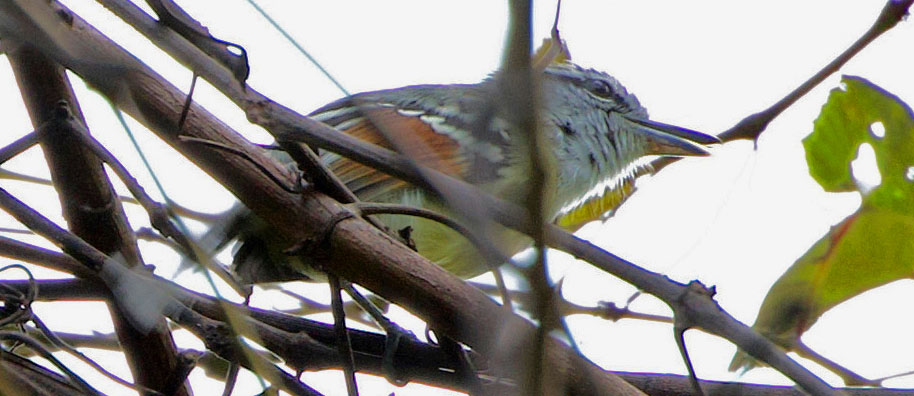 |
| |
Photos: The male Black-crowned Antshrike Thamnophilus atrinucha was in the Reserva San Fransisco, Darién, Panama, on 12 Feb 2022. The male Squamate Antbird Myrmoderus squamosus was at Intervales NP, Brazil, on 1 Aug 2010. The singing male Star-throated Antwren Rhopias gularis was at Intervales NP, Brazil, on 13 July 2010. The pair of Dot-winged Antwren Microrhopias quixensis was at Rio Tigre Lodge, Costa Rica, on 26 Dec 2007. The female Spot-crowned Antvireo Dysithamnus puncticeps was at Cerro Gaital, Panama, on 20 Feb 2022. The Bicolored Antbird Gymnopithys bicolor was near Rio Tigre Lodge, Costa Rica, on 25 Dec 2007. Terence Degan photographed the Spotted Antbird Hylophylax naevioides along Pipeline Rd., Panama, on 16 Feb 2022. The female Checker-throated Stipplethroat Epinecrophylla fulviventris was in the Reserva San Fransisco, Darién, Panama, on 12 Feb 2022. Arthur Grosset photographed the Peruvian Warbling-Antbird Hypocnemis peruviana on the Peruvian side of the Rio Javarí in Sep 2003. The Large-billed Antwren Herpsilochmus longirostris was at Emas NP, Brazil, on 27 July 2010. The male and female Rusty-backed Antwren Formicivora rufa were at Emas NP, Brazil, on 25 July 2010. The male and female Barred Antshrike Thamnophilus doliatus were at Las Garzas, Panama, on 9 Feb 2022. The male Rusty-capped Antshrike Thamnophilus ruficapillus was at Itatiaia NP, Brazil, on 5 Aug 2010. The skulking female Large-tailed Antshrike Mackenziaena leachii was at Itatiaia NP, Brazil, on 6 Aug 2010.The male Fasciated Antshrike Cymbilaimus lineatus was along Pipeline Road, Panama, on 22 Feb 2022. Arthur Gusset photographed the endangered Slender Antbird Rhopornis ardesiaca at Boa Nova, Bahia, Brazil, in July 2002. The singing Rusty-winged Antwren Herpsilochmus frater was in forest east of Lake Bayano, Panama, on 15 Feb 2022.
All photos © Don Roberson; except those attributed to © Arthur Grosset and © Terence Degan, and used with permission; all rights reserved.
More of Arthur Grosset's excellent photos are on his web site.
Bibliographic note: There is no "family book" per se, although some behavioral texts have used antbirds as examples of important principles (e.g., Willis & Oniki 1978). I had long heard that the late, great Edwin O. Willis was working on a family book but apparently it was not completed. Thus the summary by Zimmer & Isler (2003) in the Handbook of the Birds of the World series was, for me, a long-awaited and much-anticipated publication! I found it to be excellent, not to mention all the sumptuous photographs found therein.
Literature cited:
Birdlife International. 2000. Threatened Birds of the World. Barcelona & Cambridge, U.K., Lynx Edicions & Birdlife International.
Dickinson, E.C., ed. 2003. The Howard & Moore Complete Checklist of the Birds of the World. 3d ed. Princeton Univ. Press, Princeton, N.J.
Fitzpatrick, J.W., and D.E. Willard. 1990. Cercomacra manu, a new species of antbird from southwestern Amazonia. Auk 107: 239–245.
Greeney, H.F., and P. F. D. Boesman. 2021. Rusty-winged Antwren (Herpsilochmus frater), version 0.6, in Birds of the World (P.G. Rodewald and B.K. Keeney, eds.). Cornell Lab of Ornithology, Ithaca, N.Y.
Hackett, S.J., and Rosenberg, K.V. 1990. Comparison of phenotypic and genetic differentiation in South American antwrens (Formicariidae). Auk. 107: 473–489.
Johansson, U.S., T.J. Parsons, M. Irestedt, and P.G.P. Ericson. 2001. Clades within "higher land birds," evaluated by nuclear DNA sequences. J. Zool. Syst. Evol. Research 39: 37–51.
Meyer de Schauensee, R. 1970. A Guide to the Birds of South America. Livingston Publ., Wynnewood, PA.
Pierpont, N., and J.W. Fitzpatrick. 1983. Specific status and behavior of Cymbilaimus sanctaemariae, the Bamboo Antshrike, from southwestern Amazonia. Auk 100: 645–652.
Remsen, J.V., Jr., and T.A. Parker. 1984. Arboreal dead-leaf-searching birds of the Neotropics. Condor 86: 36–41.
Ridgely, R.S., and G. Tudor. 1994. The Birds of South America. Vol. 2: The Suboscine Passerines. Univ of Texas, Austin.
Rosenberg, K.V. 1993. Diet selection in Amazonian antwrens: consequences of substrate specialization. Auk 110: 361–375.
Rosenberg, K.V. 1997. Ecology of dead-leaf foraging specialists and their contribution to Amazonia bird diversity, pp. 673–700 in Studies in Neotropical Ornithology Honoring Ted Parker (Remsen, J.V., Jr., ed). Ornithol. Monograph 48. A.O.U., Washington, D.C.
Sibley, C. G., and B. L. Monroe, Jr. 1990. Distribution and Taxonomy of Birds of the World. Yale Univ. Press, New Haven, CT.
South American Checklist Committee. 2004. On-line; Remsen et al,, eds. A subcommittee of the American Ornithologists' Union.
Wetmore, A. 1972. The Birds of the Republic of Panamá. Vol. 3: Passeriformes: Dendrocolaptidae (Woodcreepers) to Oxyruncidae (Sharpbills). Smithsonian Misc. Coll. 150 (3). Smithsonian Instit., Washington, D.C.
Willis, E.O. 1972. The Behavior of Spotted Antbirds. Ornith. Monographs 10. Amer. Ornith. Union, Washington, D.C.
Willis, E.O., and Y. Oniki. 1978. Birds and army ants. Ann. Rev. Ecolo. Syst. 9: 243–263.
Willis, E.O., and Y. Oniki. 1981. Notes of the Slender Antbird. Wilson Bull. 93: 103–107.
Zimmer, K.J., and M.L. Isler.. 2003. Family Thamnophilidae (Antbirds), pp. 448–681 in Handbook of the Birds of the World (del Hoyo, J., A. Elliott & D.A. Christie, eds). Vol. 8. Lynx Edicions, Barcelona, Spain.
|
|
|



 The Antbirds are a large family found only in the Neotropics. Most reside in lowland forests where they have adapted to niches ranging from dense thornscrub to humid jungle. Almost all are plumaged in various shades of black, gray, or rufous, but male and female plumages are often dramatically different. The male Black-crowned Antshrike (above) is dark gray with black crown and black wing-coverts; the female is all rufous with brown wing-coverts. Black-crowned Antshrike is a member of genus Thamnophilus, the most familiar antshrike genus, with 30 species. Black-crowned occurs from Central America to Ecuador, and is a split from what used to be called "Slaty Antshrike." Pairs duet, and these calls often dominate lowland forests. They seem to be calling constantly during a walk along Pipeline Road, Panama.
The Antbirds are a large family found only in the Neotropics. Most reside in lowland forests where they have adapted to niches ranging from dense thornscrub to humid jungle. Almost all are plumaged in various shades of black, gray, or rufous, but male and female plumages are often dramatically different. The male Black-crowned Antshrike (above) is dark gray with black crown and black wing-coverts; the female is all rufous with brown wing-coverts. Black-crowned Antshrike is a member of genus Thamnophilus, the most familiar antshrike genus, with 30 species. Black-crowned occurs from Central America to Ecuador, and is a split from what used to be called "Slaty Antshrike." Pairs duet, and these calls often dominate lowland forests. They seem to be calling constantly during a walk along Pipeline Road, Panama.


 Unlike other suboscines about which there has been confusion over the boundaries between families (particularly in the cotinga-manakin-flycatcher sets), the Thamnophilidae are a well recognized and well defined group once it became clear that the antpittas [Grallariidae] and the antthrushes [Formicariidae] were different families. The remaining Antbirds are a monophyletic group of more than 230+ species in 60 genera. All are small to mid-sized predators, and it is easy to determine what is and what is not an antbird. Almost all species are monogamous with evidently permanent pair bonds; most antbirds live in pairs, communicating with loud, diagnostic songs. They are generally constrained in pattern and color combinations and most have similar bill shapes. Their elevational distribution is very truncated, with few species occurring above ~1300 m, and most are lowland birds below 600 m elevation. It seems remarkable that a family that shows such restrictions contains so many species. Their species richness is associated with extreme habitat and foraging specialization.
Unlike other suboscines about which there has been confusion over the boundaries between families (particularly in the cotinga-manakin-flycatcher sets), the Thamnophilidae are a well recognized and well defined group once it became clear that the antpittas [Grallariidae] and the antthrushes [Formicariidae] were different families. The remaining Antbirds are a monophyletic group of more than 230+ species in 60 genera. All are small to mid-sized predators, and it is easy to determine what is and what is not an antbird. Almost all species are monogamous with evidently permanent pair bonds; most antbirds live in pairs, communicating with loud, diagnostic songs. They are generally constrained in pattern and color combinations and most have similar bill shapes. Their elevational distribution is very truncated, with few species occurring above ~1300 m, and most are lowland birds below 600 m elevation. It seems remarkable that a family that shows such restrictions contains so many species. Their species richness is associated with extreme habitat and foraging specialization. Although most members of the Antbird family have the word "ant" in their name, that does not imply that they all eat ants. Their diet is almost exclusively arthropods. However, a subset of Antbirds are known to follow "army ants". I think that perhaps the most fascinating group of Antbirds are the dedicated ant-swarm followers. These follow "army-ants" [subfamily Dorylinae] and especially the widespread Eciton burchelli, "a diurnal swarm raider, fanning out along broad fronts containing hundreds of thousands of ravenous carnivorous ants. In the process, these flush large number of arthropods and small vertebrates, many of which are normally concealed in leaf litter. Ahead of the swarm await opportunistic birds and parasitic wasps and flies, ready to pounce on potential prey or hosts fleeing the ants. The birds do not eat the ants. . . rather, the army ants provide an important service that greatly increases foraging efficiency... the bird allow the ants to act as 'beater,' which drive an abundance of prey right into their laps;" Zimmer & Isler (2003).
Although most members of the Antbird family have the word "ant" in their name, that does not imply that they all eat ants. Their diet is almost exclusively arthropods. However, a subset of Antbirds are known to follow "army ants". I think that perhaps the most fascinating group of Antbirds are the dedicated ant-swarm followers. These follow "army-ants" [subfamily Dorylinae] and especially the widespread Eciton burchelli, "a diurnal swarm raider, fanning out along broad fronts containing hundreds of thousands of ravenous carnivorous ants. In the process, these flush large number of arthropods and small vertebrates, many of which are normally concealed in leaf litter. Ahead of the swarm await opportunistic birds and parasitic wasps and flies, ready to pounce on potential prey or hosts fleeing the ants. The birds do not eat the ants. . . rather, the army ants provide an important service that greatly increases foraging efficiency... the bird allow the ants to act as 'beater,' which drive an abundance of prey right into their laps;" Zimmer & Isler (2003). Another ant-follower is Spotted Antbird, ranging from Central America to Ecuador (nice shot from Panama by Terence Degan, right). It is one of three species in genus Hylophylax, which means "woodland watcher" in Latin. The impression that the Spotted Antbird is a "spotted watcher of the woodland" is also mirrored in Panama's Darién province where the species is locally known as 'corregidor' (mayor) for its apparent behavior of directing the activities of other birds found with it, presumably at army ant swarms (Wetmore 1972, Willis 1972).
Another ant-follower is Spotted Antbird, ranging from Central America to Ecuador (nice shot from Panama by Terence Degan, right). It is one of three species in genus Hylophylax, which means "woodland watcher" in Latin. The impression that the Spotted Antbird is a "spotted watcher of the woodland" is also mirrored in Panama's Darién province where the species is locally known as 'corregidor' (mayor) for its apparent behavior of directing the activities of other birds found with it, presumably at army ant swarms (Wetmore 1972, Willis 1972).  Much has been learned about antbirds in recent decades, with a multitude of new species that were discovered within the last 40 years, and many others elevated from previously lumped groups, at a rapid pace, even among authorities strictly conforming to the biological species concept. For example, Sibley & Monroe (1990) listed 188 species of antbirds. A dozen years later, Dickinson (2003) listed 206 while Zimmer & Isler (2003) tallied 209 species. This was an addition of 21 species in those 13 years and illustrated how rapidly new information was being gathered in South America. At this update (2022), using Clements/SACC's lists, the total is 237 species (and I expect more splits in the future).
Much has been learned about antbirds in recent decades, with a multitude of new species that were discovered within the last 40 years, and many others elevated from previously lumped groups, at a rapid pace, even among authorities strictly conforming to the biological species concept. For example, Sibley & Monroe (1990) listed 188 species of antbirds. A dozen years later, Dickinson (2003) listed 206 while Zimmer & Isler (2003) tallied 209 species. This was an addition of 21 species in those 13 years and illustrated how rapidly new information was being gathered in South America. At this update (2022), using Clements/SACC's lists, the total is 237 species (and I expect more splits in the future).  When my little party of California birders visited Explorer's Inn in southeastern Peru in 1987, we came upon researcher Ken Rosenberg, then working on post-graduate studies. He was studying "dead leaf gleaners" — most of them antwrens but also some antshrikes and birds from other families — in a broadscale conceptual project that had first been proposed by Van Remsen and Ted Parker (e.g., Remsen & Parker 1984). In an evergreen forest of broadleaf trees, there is always an abundance of hanging dead leaves. These are perfect places to hide nocturnal foragers during the day. What the LSU researchers found, including in the studies eventually published by Rosenberg (1993, 1997), is that specific antbirds rely heavily on dead-leaf-foraging for their livelihood. Many search the dead leaves for anything hidden inside while moving with a mixed species flock. They are hanging upside down and peering into clusters of dead leaves while others in the flock are searching branches or live leaves. Some species are "obligate" dead-leafers, with 99% of their prey taken that way. Examples include Ornate Antwren Myrmotherula ornata and White-flanked Antwren M. axillaris, and all of the Epinecrophylla stipplethroats.
When my little party of California birders visited Explorer's Inn in southeastern Peru in 1987, we came upon researcher Ken Rosenberg, then working on post-graduate studies. He was studying "dead leaf gleaners" — most of them antwrens but also some antshrikes and birds from other families — in a broadscale conceptual project that had first been proposed by Van Remsen and Ted Parker (e.g., Remsen & Parker 1984). In an evergreen forest of broadleaf trees, there is always an abundance of hanging dead leaves. These are perfect places to hide nocturnal foragers during the day. What the LSU researchers found, including in the studies eventually published by Rosenberg (1993, 1997), is that specific antbirds rely heavily on dead-leaf-foraging for their livelihood. Many search the dead leaves for anything hidden inside while moving with a mixed species flock. They are hanging upside down and peering into clusters of dead leaves while others in the flock are searching branches or live leaves. Some species are "obligate" dead-leafers, with 99% of their prey taken that way. Examples include Ornate Antwren Myrmotherula ornata and White-flanked Antwren M. axillaris, and all of the Epinecrophylla stipplethroats.  Yet another part of the fascinating story of antbirds is their part in the mixed-species flocks in the Neotropical lowland forests. There are canopy flocks, mid-story flocks, and undergrowth flocks, often composed of 25-50 individuals of 10-30 species. Antwrens are particularly common in the upper-level flocks, and often the 'core' species is an antwren. It is not unusual to have a half-dozen antwren species in a good Amazonian forest flock. Many of them are small Myrmotherula antwrens or stipplethroats, but often there will be a larger Herpsilochmus antwren pair. An example is Large-billed Antwren (left), of central South American in cerrado, gallery woodlots, or river island. There are 18 species in genus Herpsilochmus, and male plumage is a typical mix of gray, black and white in all species. n contrast, female plumages are more distinctive; the Large-billed female has a bright orange head and breast.
Yet another part of the fascinating story of antbirds is their part in the mixed-species flocks in the Neotropical lowland forests. There are canopy flocks, mid-story flocks, and undergrowth flocks, often composed of 25-50 individuals of 10-30 species. Antwrens are particularly common in the upper-level flocks, and often the 'core' species is an antwren. It is not unusual to have a half-dozen antwren species in a good Amazonian forest flock. Many of them are small Myrmotherula antwrens or stipplethroats, but often there will be a larger Herpsilochmus antwren pair. An example is Large-billed Antwren (left), of central South American in cerrado, gallery woodlots, or river island. There are 18 species in genus Herpsilochmus, and male plumage is a typical mix of gray, black and white in all species. n contrast, female plumages are more distinctive; the Large-billed female has a bright orange head and breast. 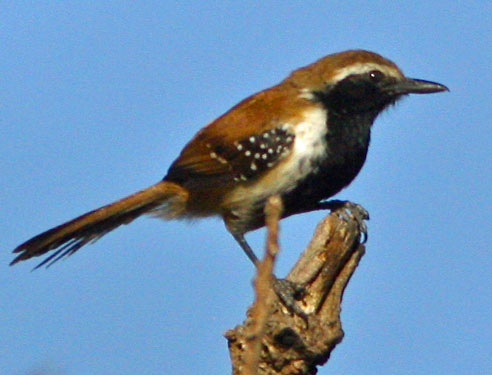
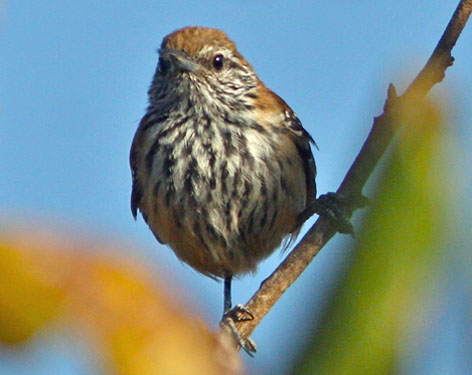
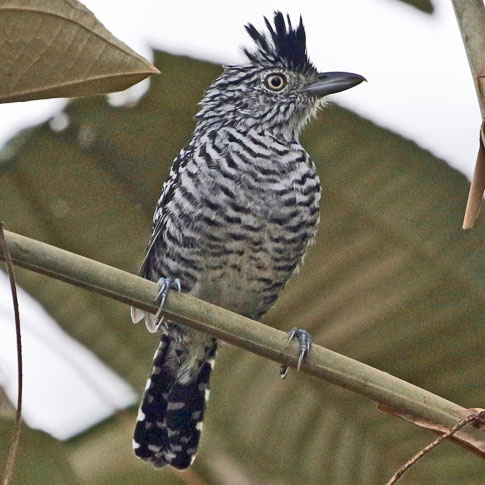

 Among the Thamnophilidae, antshrikes might be the most conspicuous because of their sometimes aggressive behavior, their rollicking calls, the conspicuous crest on some species, and their largish size for this family. Barred Antshrike (above) has perhaps the widest range of any of the family, occurring from southern Mexico (to northern Argentina. Zimmer & Isler (2003) recognize a dozen races. It is a common, well-known, and marvelous bird with much duetting among pairs. The photos above are of a pair: male (left) and female (right). Sexual dimorphism is great among most antshrikes, with males tending toward more blacks and grays, and females sporting rufous or rusty tones. Barred Antshrike is one of 30 species in genus Thamnophilus, and by far the best-studied; another is Rufous-capped Antshrike (right, a male), about which very little is known. It has a patchy distribution along the eastern foothills of the Andes, and then again in southeastern Brazil, where this pair was in dense scrub in the foothills.
Among the Thamnophilidae, antshrikes might be the most conspicuous because of their sometimes aggressive behavior, their rollicking calls, the conspicuous crest on some species, and their largish size for this family. Barred Antshrike (above) has perhaps the widest range of any of the family, occurring from southern Mexico (to northern Argentina. Zimmer & Isler (2003) recognize a dozen races. It is a common, well-known, and marvelous bird with much duetting among pairs. The photos above are of a pair: male (left) and female (right). Sexual dimorphism is great among most antshrikes, with males tending toward more blacks and grays, and females sporting rufous or rusty tones. Barred Antshrike is one of 30 species in genus Thamnophilus, and by far the best-studied; another is Rufous-capped Antshrike (right, a male), about which very little is known. It has a patchy distribution along the eastern foothills of the Andes, and then again in southeastern Brazil, where this pair was in dense scrub in the foothills.
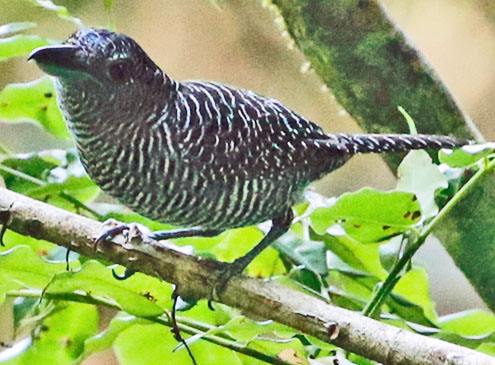
 It is often those rare and specialized antbirds that capture the attention of world birders. Slender Antbird, a female of which is so beautifully shown in this Arthur Grosset shot (right), is found only locally in two states in eastern Brazil, among a specialized habitat known as mata-de-cipó — understory of remnants of hillside deciduous forest with many lianas [cipiós] and high precipitation. This restricted range species is considered Endangered (Birdlife International 2000). Additional information on the endangered Slender Antbird was published by Willis & Oniki (1981).
It is often those rare and specialized antbirds that capture the attention of world birders. Slender Antbird, a female of which is so beautifully shown in this Arthur Grosset shot (right), is found only locally in two states in eastern Brazil, among a specialized habitat known as mata-de-cipó — understory of remnants of hillside deciduous forest with many lianas [cipiós] and high precipitation. This restricted range species is considered Endangered (Birdlife International 2000). Additional information on the endangered Slender Antbird was published by Willis & Oniki (1981).